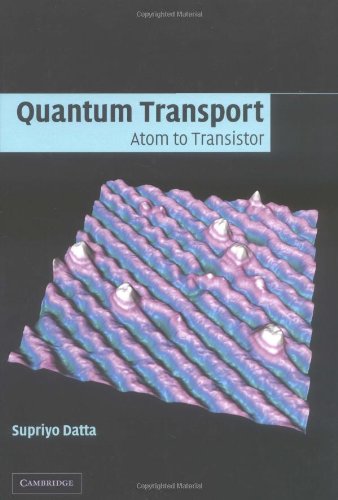

Most ebook files are in PDF format, so you can easily read them using various software such as Foxit Reader or directly on the Google Chrome browser.
Some ebook files are released by publishers in other formats such as .awz, .mobi, .epub, .fb2, etc. You may need to install specific software to read these formats on mobile/PC, such as Calibre.
Please read the tutorial at this link. https://ebooknice.com/page/post?id=faq
We offer FREE conversion to the popular formats you request; however, this may take some time. Therefore, right after payment, please email us, and we will try to provide the service as quickly as possible.
For some exceptional file formats or broken links (if any), please refrain from opening any disputes. Instead, email us first, and we will try to assist within a maximum of 6 hours.
EbookNice Team

Status:
Available0.0
0 reviews
ISBN-10 : 0521631459
ISBN-13 : 9780521631457
Author: Supriyo Datta
This book presents the conceptual framework underlying the atomistic theory of matter, emphasizing those aspects that relate to current flow. This includes some of the most advanced concepts of non-equilibrium quantum statistical mechanics. No prior acquaintance with quantum mechanics is assumed. Chapter 1 provides a description of quantum transport in elementary terms accessible to a beginner. The book then works its way from hydrogen to nanostructures, with extensive coverage of current flow. The final chapter summarizes the equations for quantum transport with illustrative examples showing how conductors evolve from the atomic to the ohmic regime as they get larger. Many numerical examples are used to provide concrete illustrations and the corresponding Matlab codes can be downloaded from the web. Videostreamed lectures, keyed to specific sections of the book, are also available through the web. This book is primarily aimed at senior and graduate students.
1 Prologue: an atomistic view of electrical resistance
1.1 Energy level diagram
1.2 What makes electrons flow?
1.3 The quantum of conductance
1.4 Potential profile
1.5 Coulomb blockade
1.6 Towards Ohm's law
EXERCISES
2 Schrödinger equation
2.1 Hydrogen atom
2.2 Method of finite differences
2.3 Examples
2.3.1 Particle in a box
2.3.2 Particle in a 3D "box"
EXERCISES
3 Self-consistent field
3.1 The self-consistent field (SCF) procedure
3.2 Relation to the multi-electron picture
3.3 Bonding
3.3.1 Valence electrons
3.3.2 Ionic bonds
3.3.3 Covalent bonds
3.4 Supplementary notes: multi-electron picture
EXERCISES
4 Basis functions
4.1 Basis functions as a computational tool
4.2 Basis functions as a conceptual tool
4.3 Equilibrium density matrix
4.4 Supplementary notes
4.4.1 Density matrix
4.4.2 Perturbation theory
EXERCISES
5 Bandstructure
5.1 Toy examples
5.2 General result
5.3 Common semiconductors
5.4 Effect of spin–orbit coupling
5.5 Supplementary notes: the Dirac equation
EXERCISES
6 Subbands
6.1 Quantum wells, wires, dots, and "nanotubes"
6.2 Density of states
6.3 Minimum resistance of a wire
6.4 Velocity of a (sub)band electron
EXERCISES
7 Capacitance
7.1 Model Hamiltonian
7.2 Electron density/density matrix
7.3 Quantum vs. electrostatic capacitance
Supplementary notes: multi-band effective mass Hamiltonian
EXERCISES
8 Level broadening
8.1 Open systems
8.2 Local density of states
8.3 Lifetime
8.4 What constitutes a contact (reservoir)?
EXERCISES
9 Coherent transport
9.1 Overview
9.2 Density matrix
9.3 Inflow/outflow
9.4 Transmission
9.5 Examples
9.5.1 An analytical example
9.5.2 Numerical example
EXERCISES
10 Non-coherent transport
10.1 Why does an atom emit light?
10.2 Examples
10.2.1 Atomic transitions
10.2.2 Interband transitions in semiconductors
10.2.3 Intraband transitions in semiconductors
10.3 Inflow and outflow
10.4 Supplementary notes: phonons
EXERCISES
11 Atom to transistor
11.1 Quantum transport equations
11.2 Physics of Ohm's law
11.2.1 Classical transport
11.2.2 Coherent transport (one subband)
11.2.3 Coherent transport (multiple subbands)
11.2.4 Quantum transport with dephasing
11.3 Where is the heat dissipated?
11.3.1 "Peltier" effect
11.4 Where is the voltage drop?
EXERCISES
12 Epilogue
s datta quantum transport atom to transistor
quantum transport atom to transistor pdf
quantum transport atom to transistor – data
quantum transistors
quantum computing transistors
Tags: Quantum Transport, Transistor, Supriyo Datta, framework underlying